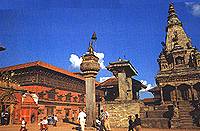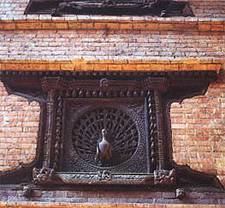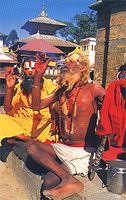UNESCO World
Heritage Sights of Nepal
 UNESCO
has declared 7 World Heritage Sites, all inside Kathmandu Valley. These seven
World Heritage Sites are all amazing man-made wonders still standing majestically
– some of them as old as 2500 years. Although their close proximity means
you could probably travel to each sight in a single day, you'll need two to three
days in the city of Kathmandu to get the full experience of each location. UNESCO
has declared 7 World Heritage Sites, all inside Kathmandu Valley. These seven
World Heritage Sites are all amazing man-made wonders still standing majestically
– some of them as old as 2500 years. Although their close proximity means
you could probably travel to each sight in a single day, you'll need two to three
days in the city of Kathmandu to get the full experience of each location.Kathmandu
Durbar Square
Lies
in the heart of the capital and is popularly known as the Hanuman Dhoka Palace
- the Gateway of Hanuman - an ancient seat of Nepalese Royalty.
The Palace consists of the huge Royal square imposing a tremendous variety of
the temples dedicated to different Hindu Gods and Goddesses. Most of the buildings
were constructed from the 15th – 18th centuries. The
Palace is named after the Hindu Monkey God, Hanuman, and is painted
completely red right next to the main entrance (the Golden Gate) of the Palace.
He is regarded as the protector of the entire Durbar Square. Also
at this location, you'll see the Taleju Temple, Jaganath Temple, Kal Bhairav;
statue of the King Pratap Malla in praying gesture (see above left), a 17th
Century Kumari Temple and the Kasthamandap from which the city got its name.  Patan
Durbar Square Patan
Durbar Square
Situated on a little plateau
across the river Bagmati river, Patan is only 7.8km south-east of Kathmandu city.
This city is considered one of the oldest among the three cities of Kathmandu
Valley.
The city was founded in
3rd century by King Veera Dev and has the distinction of being the
home of the finest Newari craft. The finest Hindu and Buddhist monuments are scattered
around but the most important monuments are in the square or close by. 
Other
features like the Golden window, the royal bath of Sundaru Chowk, the Taleju Temple,
and Keshab Narayan Chowk are worth visiting. The four stupas, located in the four
cardinal directions, were errected by Indian Emperor Ashoka the Great. Bhaktapur
Durbar Square
This is a unique city located
east of Kathmandu at 1,400m above sea level. With an area of 5 sq. kms. this unique
city is divided into 24 traditional localities. It was founded by King Ananda
Dev in 889 A.D. Bhaktapur in supposed
to have been built in the shape of a conch shell, a scared symbol of Lord Vishnu.
The world Bhaktapur means The City of Devotees. Bhaktapur;
at one time an independent city, was ruled by the Malla Kings. They were very
religious and gave importance to their artistic heritage which is evident throughout
the city. Some of the significant momuments here are:
- The Lion Gate: Built by King Bupatindra Malla in
17th century A.D.
- Golden
Gate: The main entrance to the famous 55 Window Palace and Royal Taleju. Constructed
in 1754 A.D.
- The statue of King
Bupatindra Malla.
- 55 Window
Palace: This architectural structure dominates the entire Bhadgaon Durbar Square.
It is worth admiring.
- Vastala
Temple.
- Pashupati Nath Temple.
- Nyatapole Temple.
- Bhairav
Nath Temple.
Swayambhunath
 A
Buddhist stupa on a western hills of Kathmandu. The 2,500 year old monument is
a holy site replete with symbols. The mound represents the four elements of earth,
fire, wind and water. The 13 gilded rings of the spire symbolize the 13 steps
of the ladder leading to Nirvana, the final salvation. The shrine is bedecked
in colorful prayer flags. Pilgrims and tourists pass to Swayambhumath’s holy
premises through a path of 365 steps. A
Buddhist stupa on a western hills of Kathmandu. The 2,500 year old monument is
a holy site replete with symbols. The mound represents the four elements of earth,
fire, wind and water. The 13 gilded rings of the spire symbolize the 13 steps
of the ladder leading to Nirvana, the final salvation. The shrine is bedecked
in colorful prayer flags. Pilgrims and tourists pass to Swayambhumath’s holy
premises through a path of 365 steps. Close
to the stupa is the Dewa Dharma monastery, noted for bronaze icon of the Buddha
and traditional Tibetan paintings. 
Below
are some important dates when pilgrims visit this holy site to take part in religious
activities. - Buddha Purnima,
the birth of Lord Buddha – full moon day of Baisakh (April-May)
- Gunla,
the holy Buddhist month, according to Newari calender (August – September)
- Kojagrath Purnima (September
– October)
- Samyak Day of
the Magh (January – February) every 12 years!
 Boudha
Nath Stupa Boudha
Nath Stupa
One of the oldest and the
biggest Buddhist monument ever built in the Himalayan Kingdom it is 36m high.
The stupa is unique with its three level, mandala style, platforms. The structural
features of the stupa is somewhat similar to the Swayambhunath stupa. It was built
around the 5th century A.D.
What
Mecca is to the Muslims, this Boudhanath Stupa is for Tibetan Buddhists. Every
year thousands of pilgrims flock here from all over the Himalayan region. During
the Buddhist festivals, listed with Swayambhunath above, pilgrims gather to celebrate
with great reverance to all Buddhist deities.  Pashupati
Nath Temple Pashupati
Nath Temple
Pashupati Nath is considered
one of the holiest shrines of all the Hindu temples. It is 6km. east of downtown
Kathmandu. The temple has remained the presiding deity of ruling Nepalese Royalty.
The
two tier magnificient golden temple, with four triple silver doorways, is a unique
example of the Nepalese temple architecture. It is one of the largest Hindu temple
complexes in South-Asia with hundreds of Shiva Lingam shrines and icons Hindu
Gods and Goddesses. The temple is spread out over a large area. The
main entrance, for Hindu people only, is on the western side. Tourists may peak
inside, or go on the other side of the river to have a glimpse of the temple complex
from above. During the festival of Shivaratri (February – March) 10,000's
of devotees and pligrims (many from India) visit this temple and make ceremonial
fires. Changu
Narayan Temple
Situated on a small hillock
overlooking the Kathmandu Valley, this temple is 12km. east of Kathmandu. The
temple is decorated with magnificent art works in metal and wood. This famous
temple was built in the 3rd century A.D. An inscription opposite the
temple tells about a historic event which is the first epigraphic evidence
of Nepali history. Some of the important sculptures here are:
- Viswo Roop – 8th Century A.D.
- Vishnu
Vikranta – 8 th Century A.D.
- Vishnu
mounted in his vehicle Garuda – the mythical manbird.
- Nara
Singh Vishnu in his half human and half lion form.
Topic
Sponsors: Heritage
Tours and Travels and Heritage
Trekking will guarantee immersion in the culture and heritage of Nepal. Contact
them for more information on Nepal sightseeing, its people and cultural heritage. | ![]()
![]()
